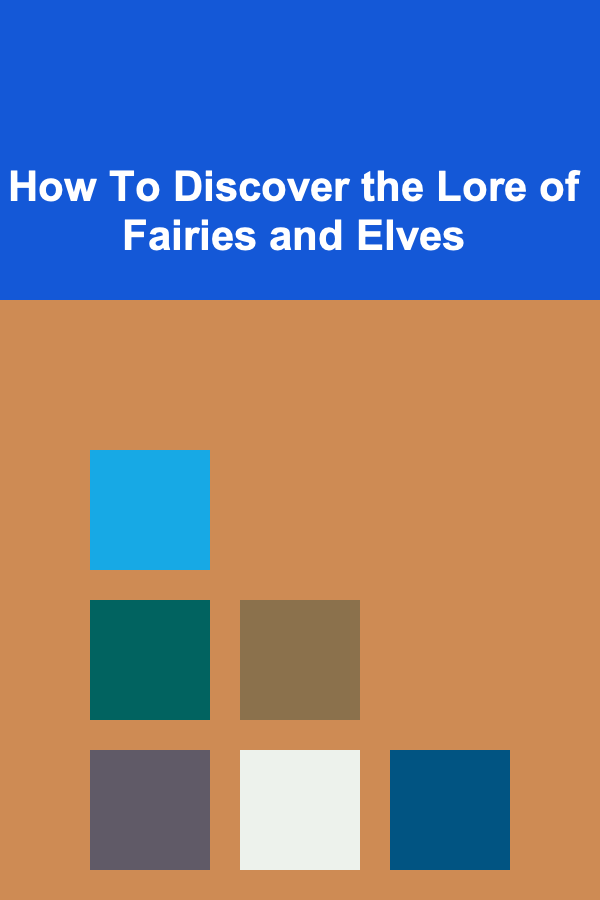
How To Discover the Lore of Fairies and Elves
ebook include PDF & Audio bundle (Micro Guide)
$12.99$11.99
Limited Time Offer! Order within the next:

Fairies and elves have captivated the human imagination for centuries, woven into the tapestry of folklore, myths, and fantasy literature across cultures. From the shimmering wings of fairies to the mysterious, ethereal beauty of elves, these creatures have been the subject of stories, art, and wonder. They symbolize a link between the mundane and the magical, the seen and the unseen. Their lore is rich and diverse, offering insights into ancient beliefs, cultural practices, and the human desire to understand the world beyond the material.
This article will delve into how to discover and engage with the lore of fairies and elves, exploring their origins, the meanings they hold, their depictions in various cultures, and how to immerse oneself in this magical world.
Understanding the Origins of Fairy and Elf Lore
Fairies: A Brief History
The origins of fairy lore are often difficult to pinpoint because these creatures are found across many different cultures, each with its own interpretation of the supernatural. The term "fairy" comes from the Latin word fata, meaning "fate," and was initially associated with the Roman goddesses of fate. However, it was in medieval Europe, particularly in Celtic and Norse traditions, that fairies began to take on the characteristics we recognize today.
In early stories, fairies were not always the whimsical, benevolent creatures we see in modern pop culture. They were often seen as dangerous, unpredictable beings who could bring misfortune if angered. The distinction between fairies, spirits, and nature gods was blurred, and it wasn't uncommon for fairies to be portrayed as mischievous or malevolent. Over time, as the influence of Christianity grew, these supernatural beings were relegated to folklore and eventually romanticized in Victorian and later literature.
In Celtic mythology, fairies are part of a complex world that includes a wide range of magical creatures. The "seelie" and "unseelie" courts of fairies are perhaps the most famous; the former was associated with more benevolent fairies, while the latter consisted of those with more sinister intentions. The "sidhe" (pronounced shee) were also an important part of Irish and Scottish folklore, believed to be a race of fairy folk living in mounds or hills.
Elves: From Norse Mythology to Tolkien
Elves have a similarly ancient history, with their roots in Norse mythology. The Old Norse word álfar refers to a group of beings who were closely related to nature. In the Poetic Edda, a primary source of Norse mythology, elves are often depicted as beautiful, ethereal beings who inhabit the world of Álfheimr, one of the Nine Worlds.
In these early myths, elves were often associated with light and darkness. Light elves were considered benevolent and were closely linked to the gods, while dark elves (or svartálfar) were seen as more mysterious and potentially harmful. Over time, the concept of elves was integrated into other cultures, with distinct interpretations emerging across Europe.
Perhaps the most famous depiction of elves in modern times comes from the works of J.R.R. Tolkien. In his Middle-earth saga, Tolkien's elves are depicted as immortal, wise, and noble beings, deeply connected to nature and magic. His elves, such as Legolas and Galadriel, became archetypes of the graceful, otherworldly beings we often imagine when we think of elves today.
Different Ways to Discover the Lore of Fairies and Elves
1. Engage with Folklore and Mythology
One of the most direct ways to explore the lore of fairies and elves is through the study of folklore and mythology. Many cultures have their own interpretations of these beings, and each interpretation offers a glimpse into the values, fears, and desires of the people who created them.
- Celtic Mythology: As mentioned earlier, Celtic traditions, particularly in Ireland and Scotland, are rich in fairy lore. The Sidhe, the Seelie Court, and the Unseelie Court are essential components of this lore. The tales often revolve around interactions between humans and fairies, where the boundaries between the two worlds are porous. Learning about the Celtic concept of the Otherworld, where these creatures dwell, provides deep insights into their mythos.
- Norse Mythology: Norse mythology offers an entirely different perspective on elves. The Æsir and Vanir gods often interacted with the elves, and the light and dark elves played roles in the shaping of the cosmos. The world of Álfheimr and the detailed descriptions of different types of elves provide a fascinating entry point into the lore.
- Slavic Folklore : Slavic traditions have their own variety of fairy creatures, such as the rusalki (water spirits) and domovoi (household spirits). While these are not elves in the traditional sense, they share many of the same attributes---magical powers, an ethereal existence, and an affinity with nature.
To start exploring, one can read collections of folktales, such as the Irish Fairy Tales compiled by W.B. Yeats, or delve into comprehensive texts like The Prose Edda by Snorri Sturluson for Norse mythology.
2. Study the Literature
Literature is a rich source for discovering the lore of fairies and elves. Beyond the ancient myths, many authors have contributed to the development of fairy and elf lore, often giving these creatures a new spin that speaks to contemporary concerns and imaginations.
- Classical Literature : William Shakespeare's A Midsummer Night's Dream is perhaps one of the best-known works that delves into fairy lore. Shakespeare's depiction of Oberon, Titania, and Puck has influenced how we think about fairies today. Similarly, Edmund Spenser's The Faerie Queene is a cornerstone of English literature, with its allegorical portrayal of fairy realms and creatures.
- Modern Fantasy : Authors like J.R.R. Tolkien, C.S. Lewis, and George R.R. Martin have shaped modern conceptions of elves and fairies. Tolkien's The Hobbit and The Lord of the Rings trilogy brought elves into the mainstream, offering a complex and detailed world where elves are depicted as ancient and wise, yet deeply connected to the land. Similarly, C.S. Lewis's The Chronicles of Narnia feature a range of magical creatures, including elves and fauns, further expanding the concept of magical beings.
- Contemporary Fantasy : More recent works, such as The Folk of the Air series by Holly Black or The Iron Fey series by Julie Kagawa, explore modern takes on fairy lore, often focusing on the tension between the human world and the hidden world of fairies. These books provide a more contemporary view of the conflict between the mortal and the magical realms.
3. Explore Art and Visual Representations
Art has long been a medium for expressing the magical and fantastical elements of fairies and elves. From medieval illustrations of the fair folk to modern fantasy art, the depiction of these creatures in visual form can offer new insights into their lore.
- Medieval and Renaissance Art: Artists from these periods often depicted fairies as ethereal, sometimes otherworldly beings who existed on the fringes of reality. The depictions of fairies in illuminated manuscripts or on the ceilings of European cathedrals offer a glimpse into how these beings were perceived in the past.
- Victorian Art: During the Victorian era, fairies were romanticized, and artists like John Anster Fitzgerald and Richard Dadd created detailed and beautiful works that focused on the whimsical, innocent side of fairy lore. These images are still popular today, shaping how we see fairies in contemporary culture.
- Modern Fantasy Art: In the modern age, fantasy artists such as Brian Froud and Alan Lee have had a profound influence on how fairies and elves are depicted. Their detailed and often darkly enchanting illustrations of these creatures have inspired generations of fantasy lovers.
4. Engage in Cultural Practices and Beliefs
The folklore surrounding fairies and elves is deeply intertwined with cultural practices and beliefs. Understanding how people once interacted with these creatures---both out of fear and reverence---can offer a deeper appreciation of their significance.
- Fairy Traditions: In some rural parts of Europe, especially in Ireland and the Scottish Highlands, people still observe practices intended to ward off fairies or appease them. Offering gifts, leaving milk out for the fairies, or taking precautions against being "charmed" by them are all aspects of folk belief that endure to this day.
- Fairy Circles : One of the most enduring fairy legends involves the idea of fairy rings, natural formations of mushrooms or grass circles that were believed to be portals to the fairy world. People would avoid stepping into these rings to prevent being whisked away by the fairies or falling under their enchantment.
- Elfin Magic: Elves, particularly in Norse and Germanic traditions, were often associated with healing, nature magic, and protection. The belief that elves had the power to influence the weather, fertility, and even personal health was widespread in rural communities. Many old superstitions, such as those surrounding illnesses and childbirth, involved offerings or rituals intended to curry favor with elves.
Bringing the Lore to Life: Engaging with Fairy and Elf Culture
1. Visit Fairy Sites and Natural Places
One of the most immersive ways to discover fairy and elf lore is to visit places that have historical connections to these creatures. In Celtic and Norse traditions, certain sites---such as stone circles, standing stones, and sacred groves---were considered to be portals to the otherworld where fairies and elves could be found.
- Ireland and Scotland : The Fairy Glen in Scotland, the Hill of Tara in Ireland, and the Giant's Causeway are all places rich with lore and steeped in the mystique of the fair folk. These areas are said to be teeming with the energy of the supernatural and are perfect for immersing yourself in the fairy world.
- Nordic Sites : In Norway, Iceland, and Sweden, you can explore the ancient landscapes that inspired much of Norse elf lore. Locations like Trollheimen (the Troll Mountains) and Álfheimr (the realm of the light elves) are key parts of the mythology and offer beautiful vistas where the mythical and real worlds seem to collide.
2. Learn the Old Languages and Texts
To truly understand the lore of fairies and elves, it's essential to learn about the languages and texts that have preserved these myths. Many fairy tales and elf legends were passed down orally and later transcribed into ancient languages.
- Old English and Old Norse : Studying Old English or Old Norse can give you access to primary texts like Beowulf or the Poetic Edda. These works contain some of the earliest written references to elves and fairies and are key to understanding how these creatures were once seen by people in the past.
- Folk Songs and Ballads : Folk music is another important source for fairy lore. Songs about selkies , changeling children, and faerie queens offer insight into how these creatures were woven into the fabric of everyday life. Many of these ballads date back hundreds of years and were passed down through generations as oral tradition.
Conclusion
The lore of fairies and elves is a rich and fascinating tapestry of myths, legends, and cultural beliefs. From their mysterious origins in ancient cultures to their modern depictions in fantasy literature, these magical beings continue to capture the imagination of people around the world. To truly discover the lore of fairies and elves, one must engage with the history, literature, and art that have preserved their stories, while also exploring the magical landscapes where these beings were believed to dwell. Whether through reading ancient texts, visiting sacred sites, or simply allowing yourself to believe in the magic of the unseen, the world of fairies and elves is one that offers endless possibilities for discovery.
Other Products

How to Build an Emergency Fund Without Feeling Overwhelmed
Read More
How to Identify Fake Antiques and Avoid Scams
Read More
How to Make Money Online as a Lawyer: 10 Actionable Ideas
Read More
How to Organize Your Closet for Seasonal Wardrobe Changes
Read More
How to Select Unique Pendant Lights for Your Kitchen Island
Read More